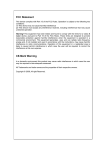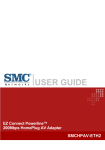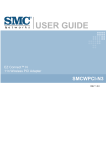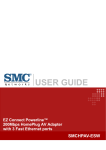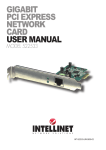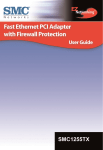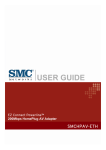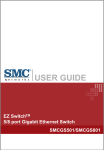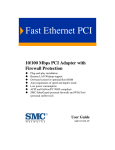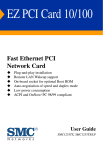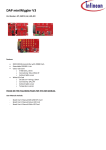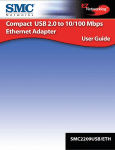Download Copyright - Edge-Core
Transcript
Copyright Information furnished by SMC Networks, Inc. (SMC) is believed to be accurate and reliable. However, no responsibility is assumed by SMC for its use, nor for any infringements of patents or other rights of third parties which may result from its use. No license is granted by implication or otherwise under any patent or patent rights of SMC. SMC reserves the right to change specifications at any time without notice. Copyright © 2010 by SMC Networks, Inc. 20 Mason Irvine, CA 92618 All rights reserved. Printed in China Trademarks: SMC is a registered trademark; and EZ Card™ 10/100 is a trademark of SMC Networks, Inc. Other product and company names are trademarks or registered trademarks of their respective holders. Warranty and Product Registration To register SMC products and to review the detailed warranty statement, please check www.smc.com for the warranty terms in your country/region. SMC Networks, Inc. 20 Mason Irvine, CA 92618 Compliances FCC Statement This device compiles with Part 15 of the FCC Rules. Operation is subject to the following two conditions: (1) This device may not cause harmful interference, and (2) This device must accept any interference received, including interference that may cause undesired operation. Warning! This equipment has been tested and found to comply with the limits for a Class B digital device, pursuant to Part 15 of the FCC Rules. These limits are designed to provide reasonable protection against harmful interference when the equipment is operated in a commercial environment. This equipment generates, uses and can radiate radio frequency energy and, if not installed and used in accordance with the instructions, may cause harmful interference to radio communications. Operation of this equipment in a residential area is likely to cause harmful interference in which case the user will be required to correct the interference at his own expense. CE-Mark Warning Countries of Operation & Conditions of Use in the European Community SMC contact for these products in Europe is: SMC Networks Spain, S.L. Edificio Conata II, Group CTSG Fructuos Gelabert 6-8 2o2a 08970 Sant Joan Despi, Barcolona,Spain This device complies with the essential requirements of the R&TTE Directive 1999/5/EC. The following test methods have been applied in order to prove presumption of conformity with the essential requirements of the R&TTE Directive 1999/5/EC: EN 55022:2006+A1:2007 Class B EN 55024:1998+A1: 2001+A2: 2003 IEC 61000-4-2: 2001 IEC 61000-4-3: 2006 IEC 61000-4-4: 2004 IEC 61000-4-5: 2005 IEC 61000-4-6: 2006 IEC 61000-4-8: 2001 IEC 61000-4-11: 2004 LVD: EN60950-1:2006/A11:2009 1. Introduction Thanks for choosing the SMC 10/100 Fast-Ethernet PCI Card, the SMC1255TX-2. This document describes the Installation of SMC1255TX-2. This adapter supports 10BASE-T/100BASE-TX Fast Ethernet and complies with the electrical and protocol requirements of the PCI Local Bus Specification, revision 2.2. The Wake-On-LAN feature is supported by the adapter. 1.1 Features The 10/100 Fast Ethernet PCI adapter is a cost effective, high-performance network interface card. It operates in 10BASE-T and 100BASE-TX modes and integrates easily with any Fast Ethernet hub, switch or router. IEEE 802.3 (10BASE-T) and IEEE 802.3u (100BASE-TX) standards 32-bit bus master for high throughput and low CPU utilization Wake-On-LAN Full-duplex operation at both 10Mbps and 100Mbps 10/100Mbps auto-sensing Diagnostic LED for troubleshooting Single shield RJ-45 connector for using at either Speed (Category 3, 4 or 5 UTP cable for 10Mbps Operation, and Category 5 UTP cable for 100Mbps Operation) Plug and Play installation. Test program (including Wake-On-LAN events) Network drivers on the CD for Windows 95, 98, ME, NT, 2000, XP, Vista, NetWare, SCO Unix and Packet driver. FCC, CE certification 1.2 System Requirements To use the adapter, you need the following components: A PCI master mode expansion slot that is compliant with PCI bus specifications, revisions 2.2 Driver/ Manual CD The following cables: To operate at 10Mbps, a Category 3, 4, 5 UTP Cable To operate at 100Mbps, a Category 5 UTP cable 2. Installation This section describes how to install the adapter. For connecting to the network, you must have the following: 1. Network adapter card installed to your computer. 2. Cabling (compatible with network topology) 3. CD-ROM for the adapter card containing the drivers 2.1 Unpack and Inspect Caution: Under ordinary circumstances, this adapter card will not be affected by static charge as may be received through your body during handling of the unit. In special circumstances where you may carry an extraordinarily high static charge, it’s recommended to reduce the charge by touching a ground before handling the adapter card. Open the shipping gift box and carefully remove all items. In addition to this User’s Manual, please check the following items: One 10/100 Fast Ethernet PCI Adapter Card One Driver/Manual CD One Low Profile Bracket Note: If any of the listed items are missing, please contact your distributor or reseller 2.2 Install the Adapter 1. 2. Turn off the computer. Open the computer’s cover, in accordance with its manual, remove any screws that fasten the cover to the case. 3. Find a free PCI slot and remove the slot cover from the case (keep the screw). 4. Insert the PCI card directly into the PCI slot by pushing it down carefully until it slides into the PCI connector. 5. Fasten the PCI card to the computer case with the screw from the slot cover (step 3). 6. Close the computer cover and fix it with the screws that were previously removed to the case. 7. Connect the network cable (CAT3 or CAT5 UTP)* to the RJ-45 network connector of the new installed adapter card and the other end to router, switch or any other networking device. 8. Turn on the computer. If the BIOS section of your computer’s boot program is Plug and Play compliant, then at power up the BIOS will configure any newly installed adapter automatically. Note: Due to some Plug-and-Play BIOS problems, it happens occasionally that a newly installed adapter is assigned an Interrupt Number which is already used by another device. In such a case, the conflict of Interrupt Number will cause faults in the behavior of both devices. Then it is necessary to run the CMOS Setup utility, and manually assign a non-conflict Interrupt Number. 2.3 Fast Ethernet Connection (100Mbps) Category 5 UTP cable is required for Fast Ethernet (100Mbps) operation. The maximum cable run between the adapter and the supporting hub, switch or router is 300ft (100m). Make the network connection by plugging one end of the cable into the RJ-45 receptacle of the adapter, and the other end into one port in the hub, switch or router. 2.4 Ethernet Connection (10Mbps ) Category 3, Category 4, and Category 5 UTP cable, as well as EIA/TIA 568 100 ohm STP cable is required for Ethernet (10Mbps) operation. The maximum cable length run between this adapter and the supporting hub, switch or router is 300 ft (100m). Make the network connection by plugging one end of the cable into the RJ-45 receptacle of this adapter, and the other end into the hub, switch or router. 2.5 Drivers and Utilities CD The [Divers/Manual] CD contains drivers for all popular operating systems: Novell NetWare(client /server) Windows NT3.5/NT4.0/2000 Windows 95/98/ME/XP/Vista/Win7 Microsoft Client (NDIS 2.0 DOS/OS2) Windows For Workgroup 3.11 MacOS 10.1 Linux Kernel 2.4 or later 2.6 Test Program Note: The test program can not be used in Windows 95/98 DOS mode. Do not load any device drivers, memory manager, and anti-virus software. The test program can only work in clean DOS prompt. This test program verifies the configuration of the adapter and helps to isolate any faults in the operation. The test procedures are optional, and will only be useful in the unlikely event that there is a problem, such as an interrupt number conflict among your computer’s add-on cards. If your adapter provides normal operation, you don’t need to follow the test procedures. At your DOS prompt, type the following command (considering your CD-ROM drive is E:): E:\rset8139.exe <Enter> A menu will open as follows below: View Current Configuration Set Up New Configuration Run Diagnostics Exit RSET8139 Choose <Set Up New Configuration> to set up the Network Speed, 10Mbps or 100Mbps, and Transmission Mode, Full- or Half Duplex, and so on. Choose <Run Diagnostics> to run the adapter test program. Adapter test program includes: <Run EEPROM Test>, <Run Diagnostics on Board>, <Run Diagnostics on Network>, and <Run Power Management Test>. After choosing the <Run Diagnostics on Board>, you will see the following screen: Node ID........: 00 e0 7d c0 00 01 Network Speed..: 100Mbps I/O Base ......: E000H Interrupt .....: 11 Full-Duplex ...: Disabled Pass Count Fail Count A. I/O Register B. 100Mbps Loopback C. 10Mbps Loopback D. Cable Connection <Cable Connection> test shows you that the connection link might fail because either the cable is not connected or the cable link fails. For the <Run Diagnostics on Network> test, it is necessary to connect your computer with a supporting hub, switch, router or another computer. This is a "Ping-Pong" test. This test cannot be completed unless there are minimum two computers on the LAN for sending or receiving the test packets. For the <Run Diagnostics On Network> test Ethernet Address 00E07DC00002 Target Machine Ethernet Address 00E07DC00001 Master Machine Network Master Machine: Master machine sends magic packet or Wake up frame through the network. Target Machine: Target machine is notified whenever a qualified wakeup packet is received. To Wake-Up The Target Machine With A Magic Packet Step1: Target Machine: Check BIOS <POWER MANGEMENT SETUP> ACPI, Wake-On-LAN function must be enabled. Step2: Target Machine: Select <Target Machine> then the system will setup a wake-up event and wait for a magic packet to do the system wake-up Step3: Master Machine: Select <Magic Packet> to send a magic packet and wake-up the target machine. The MAC address of the target machine is required, such as: 00 e0 7d c0 00 02. Step4: Target Machine: ACPI Testing events will be displayed Device State 1: PASS Device State 2: PASS Device State 3: PASS Step5: Target Machine: Power down the target machine. Step6: Master Machine: Send a magic packet to wake-up the target machine. Test The Wake-up Frame Step1: Target Machine: Select <Target Machine> then the system will setup a wake-up event and wait a magic packet to do the system wake-up Step2: Master Machine: Select<WakeUp Frame> to send a wake-up frame. Step3: Target Machine: ACPI Testing events will be show Device State 1: PASS Device State 2: PASS Device State 3: PASS Quick Installation Guide Please take the following steps for driver installation. Please note that the drive “E:\” represents your CD-ROM drive. Microsoft Windows 95/Windows 98/Windows ME 1. Turn off the computer. 2. Insert the adapter into an available PCI slot. 3. Restart the computer. 4. After Microsoft Windows rebooted, the PCI Adapter will be found. 5. The system will prompt for driver installation. 6. Insert the “Driver and Utilities” CD into CD-ROM drive and press <Enter>. 7. For Windows 95, Key in E:\ path to install driver for the adapter 8. For Windows 98, Key in E:\w98_2000 path to install driver for the adapter 9. For Windows ME, Key in E:\winme path to install driver for the adapter 10. The Windows system will install the driver automatically. 11. Reboot the Windows system. Windows NT 1. Turn off the computer. 2. Insert the adapter into an available PCI slot. 3. Restart the computer. 4. Click “Start” menu bar and select “Setting” item then “Control Panel” 5. Select the “Network” icon 6. If this is the first time to install a network on the machine then the system will ask “YES” or “NO” to install the network adapter. Please select “YES” 7. If the computer already installed a network before then you need to select “Interface” -> “Add” 8. The system will prompt for driver installation. 9. Insert the Driver CD into CD-ROM drive and press <Enter>. 10. Key in E:\winnt path to install driver for the adapter 11. The Windows system will install the driver automatically. 12. Reboot the Windows system. Microsoft Windows 2000 1. Turn off the computer. 2. Insert the adapter into an available PCI slot. 3. Restart the computer. 4. After Microsoft Windows rebooted, the PCI Adapter will be found and the system will assign the default network driver to the adapter. 5. Select “Control Panel” from “Start” menu bar 6. Select “Network and Dial-Up Connection” folder then click “Local Area Connection” and “Properties”. 7. Click “Configure” item and select “Driver” 8. From the “Driver” item then choose “Update Driver” 9. The system will prompt for driver search, either by auto search or “Display a list of known drivers ….”. Please select second one “Display …” 10. The system will prompt for driver installation and please select “Have Disk” button. 11. Key in E:\w98_2000 path to install driver for the adapter Microsoft Windows XP 1. Turn off the computer. 2. Insert the adapter into an available PCI slot. 3. Restart the computer. 4. After Microsoft Windows rebooted, the PCI Adapter will be found and the system will assign the default network driver to the adapter. 5. Select “Control Panel” from “Start” menu bar 6. Select “Network Connection” folder then click “Local Area Connection” and “Properties”. 7. Click “Configure” item and select “Driver” 8. From the “Driver” item then choose “Update Driver” 9. Choose “Install from a list or specific location (Advanced)” and click “Next”. 10. Select “Don’t search, I will choose the driver to install” then click “Next”. 11. The system will prompt for driver installation and please select “Have Disk” button. 12. Key in E:\WinXP path to install driver for the adapter. Microsoft Windows Vista 1. Turn off the computer. 2. Insert the adapter into an available PCI slot. 3. Restart the computer. 4. After Microsoft Windows rebooted, the PCI Adapter will be found and the system will assign the default network driver to the adapter. 5. Select “Control Panel” from “Start” menu bar 6. Select System > Device manager > Network Adapters 7. Double click this adapter, select “update driver” button. Click Browse and select computer > your CD Rom drive> WVISTA32/64. Click OK to start installation. 8. Wait until the installation finished and close this window. Microsoft Windows 7 1. Turn off the computer. 2. Insert the adapter into an available PCI slot. 3. Power on the computer. 4. Windows 7 supports inbox driver for the adapter, and the system will install the driver automatically. 5. If you want to update the driver, please continue the following steps. 6. Right click Computer > Manager > Device Manager > Network Adapters 7. Double click this adapter, select “Update driver software” button. 8. Select “Browse my computer for driver software”. 9. Key in E:\Win7 path and then click “Next” to update the driver for the adapter. 10. Wait until the installation finished and close this window. Novell Netware System Please execute the following commands: For Netware Client LSL RTSODI IPXODI NETX or VLM F: LOGIN <USERNAME> For Netware Server LOAD RTSSRV BIND IPX TO RTSSRV The help file in the CD will describe the detail driver installation information for all popular operating systems.

















